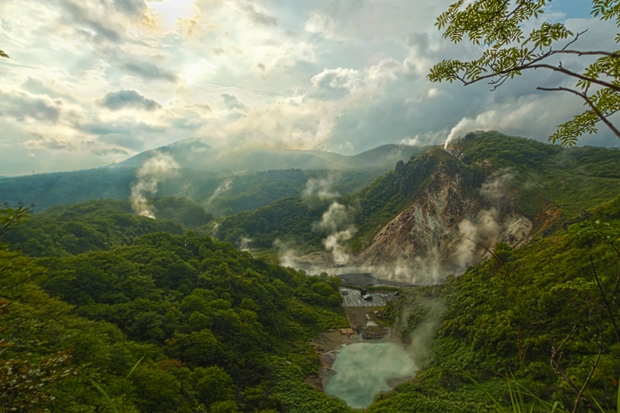I’m hovering starkers beside a hot spring, or onsen, in a faded resort in southern Japan, while the Japanese grandmother standing naked next to me explains the form for the steaming pool I am about to enter. It’s an open-air mud hot spring, known as a doroyu and quite unusual, even in Japan, where the hyperactive geology means onsen of all kinds spring up — literally — everywhere.
I love a scalding bath, so it was perhaps inevitable that I should love onsen from the moment I first dipped a toe in one many years ago, close to Mt Fuji on a day trip from Tokyo. The ritual of washing before bathing, soaking in piping hot waters, the tranquillity, the beautiful settings, the deep sense of relaxation — I simply can’t get enough. Which is how I ended up in the city of Beppu — my first stop on a circumnavigation of the island of Kyushu in search of hot springs.
Kyushu is the most southerly of Japan’s four main islands. Its gateway city, Fukuoka, is five hours from Tokyo by the fastest bullet train, is famous for its ramen noodles and recently got its first Michelin guide and direct flights to Europe, thanks to KLM.
South-east of Fukuoka is Beppu — a paradise for hot-spring lovers and the obvious place to start an onsen odyssey. The city has everything from open-air baths known as rotenburo (I recommend Ichinoide Kaikan in the hills overlooking the city) to Japanese-style sauna-cum-steam-baths called mushiyu. Visitors also come to see the hot-spring ‘hells’, which are scalding, sulphurous and not for bathing in.
And it was next door to the touristy Monk’s Hell — where pools of thermal mud rise up from the ground in bubbles that resemble a monk’s tonsure — that I found the tiny, heavenly mud hot spring, Koudei Onsen. Here, on the instructions of my new mentor, I wallowed in a bath of warm grey water before stepping out into the sunshine to let the mud dry on my skin. She sipped on cooled hot-spring water and explained that she visited the mud baths every day. It showed: she looked at least a decade younger than her 62 years.
But it’s sand, not mud, baths that are Beppu’s signature. On the seafront, attendants sweat it out burying visitors up to their necks in hot black sand. Here, sensibly, you don’t go naked — so, wrapped in a cotton kimono known as a yukata, I lay down on the beach as shovel-loads of sand were swept up around my body and deposited across my chest, up to my shoulders and neck and down to my toes. The sand was heavy and claustrophobic, and the heat soon became unbearable. After repeatedly summoning the attendant to mop up the sweat that was trickling from my forehead and tickling my nose, I unearthed myself and abandoned the sand bath.
I then travelled inland to the hot spring town of Yufuin, in a valley of paddy fields ringed by mountain peaks. One of the destinations on the new Seven Stars ‘cruise train’ — Kyushu’s answer to the Orient Express — Yufuin is home to plenty of upmarket onsen in expensive traditional inns (ryokan), but also tiny public hot springs in lovely locations. On one particularly rainy day, I discovered Shitanyu bathhouse on Kinrin Lake. Popping 200 yen in the honesty box, I spent a peaceful hour in the rustic indoor-outdoor pool, while the rain dripped from the thatch and the breeze cooled my head. Thankfully the place was deserted, as the bath was, unusually, mixed bathing.
Off Kyushu’s southern coast lay the most memorable onsen of my journey — a hot spring in the sea, accessible only at low tide. It was on the island of Yakushima, which is designated a Unesco World Heritage Site for its ancient cedar trees. Visitors (including myself) hike into the centre of the island to see these giants, and so the Hirauchi ‘hot spring in the sea’ was just the tonic for tired trekkers — and also the bashful. I visited at low tide in the middle of the night, when it was so dark on the beach that all you could see was the Milky Way and the moon reflected on bare bottoms.
Back on mainland Kyushu, and en route to Nagasaki, my final destination, I stopped in Unzen on the west coast, where I soaked in its uniquely sulphurous springs and ate onsen tamago — boiled eggs that are to be found cooking in hells all over the country. Here, the backdrop was Mt Heisei-Shinzan, a peak created by an eruption just 20 years ago — a dramatic reminder of the violent geology that gives birth to Kyushu’s varied and wondrous onsen.
Onsen dos and don’ts
Do learn the Japanese characters for ‘male’ and ‘female’.
Don’t wear a swimsuit.
Do wash before entering the tub.
Do use the small towel provided to cover your modesty. Don’t wring it out in the tub.
Do talk quietly.
Don’t swim, dunk your head or take selfies.






Comments